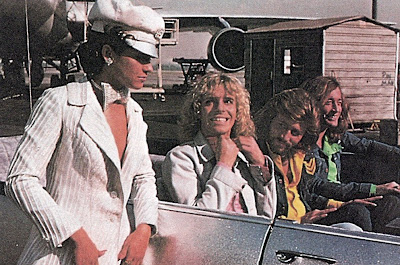 The Lonely Hearts Club Band returns to Heartland.
The Lonely Hearts Club Band returns to Heartland.
"For the benefit of Mr. Kite
There will be a show tonight on trampoline
The Hendersons will all be there
Late of Pablo Fanques Fair -- what a scene!"
-- John Lennon/Paul McCartney
Alerted by Strawberry of Heartland's corruption, Billy, Mark, Dave and Bob agree to stage a benefit concert in Heartland. It may not save the town but it will raise some money for a national search for the musical instruments. The momentous occasion will also bring hope to the depressed citizens of the unfortunate town.
 The ballyhoo for the benefit -- clowns, tumbling acrobats, a dancing horse...
The ballyhoo for the benefit -- clowns, tumbling acrobats, a dancing horse...The day of the benefit is full of festivity as the Lonely Hearts Club Band, now rock superstars, return to their hometown. They bring with them dancers and acrobats, clowns and tumblers, even a dancing horse, as the whole town is swept into the excitement.
At the concert that night, Earth, Wind and Fire are the main attraction.
 The guest-stars for the benefit are Earth, Wind and Fire. The lead singer is Maurice White.
The guest-stars for the benefit are Earth, Wind and Fire. The lead singer is Maurice White.Earth, Wind and Fire too time out from a 70-city tour to join the filming of the benefit sequence. Their first motion picture appearance had been in "That's the Way of the World," the soundtrack of which still continues to be one of the group's biggest sellers. Their latest album, "All 'n All," had just shipped platinum on top of rave reviews.

Their rendition of "Got to Get You Into My Life" is the culmination of the Benefit sequence, a scene which took quite a few days to shoot. Dancers and acrobats were rehearsed carefully by Michael Schultz and Pat Birch. Extras were brought in to fill the town square for scenes with as many as four cameras that were running simultaneously. Peter Frampton, The Bee Gees, and George Burns proved themselves to be an agile dance team. During the evening sessions, the hot-air balloon often was tossed by the winds and took additional men to restrain it from breaking its moorings. But as Earth, Wind and Fire with their lead singer, Maurice White, took over the stage, the days of hard work were soon forgotten. Their song is one of the special highlights of "Sgt. Pepper's Lonely Hearts Club Band."
"The band begins at ten to six
When Mr. K. performs his tricks without a sound.
And Mr. H. will demonstrate
Ten somersets he'll undertake on solid ground
Having been some days in preparation
A splendid time is guaranteed for all..."
--John Lennon/Paul McCartney
 Mr. Kite dances with the Lonely Hearts Club Band.
Mr. Kite dances with the Lonely Hearts Club Band.


 Peter, Barry & Robin wait for Maurice to ready the balloon for the chase.
Peter, Barry & Robin wait for Maurice to ready the balloon for the chase.


















































